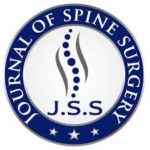Influence of psychosocial and sociodemographic factors in the surgical management of traumatic cervicothoracic spinal cord injury at level I and II trauma centers in the United States
Matthew J. Hagan1, Nathan J. Pertsch, Owen P. Leary, Bryan Zheng, Joaquin Q. Camara-Quintana, Tianyi Niu1, Kyle Mueller, Zain Boghani, Albert E. Telfeian, Ziya L. Gokaslan, Adetokunbo A. Oyelese, Jared S. Fridley
 Background: Socioeconomic factors can bias clinician decision-making in many areas of medicine. Psychosocial characteristics such as diagnosis of alcoholism, substance abuse, and major psychiatric disorder are emerging as potential sources of conscious and unconscious bias. We hypothesized that these psychosocial factors, in addition to socioeconomic factors, may impact the decision to operate on patients with a traumatic cervicothoracic fracture and associated spinal cord injury (SCI).
Background: Socioeconomic factors can bias clinician decision-making in many areas of medicine. Psychosocial characteristics such as diagnosis of alcoholism, substance abuse, and major psychiatric disorder are emerging as potential sources of conscious and unconscious bias. We hypothesized that these psychosocial factors, in addition to socioeconomic factors, may impact the decision to operate on patients with a traumatic cervicothoracic fracture and associated spinal cord injury (SCI).
Methods: We performed a cohort analysis using clinical data from 2012–2016 in the American College of Surgeons (ACS) National Trauma Data Bank at academic level I and II trauma centers. Patients were eligible if they had a diagnosis of cervicothoracic fracture with SCI. Using ICD codes, we evaluated baseline characteristics including race; insurance status; diagnosis of alcoholism, substance abuse, or major psychiatric disorder; admission drug screen and blood alcohol level; injury characteristics and severity; and hospital characteristics including geographic region, non-profit status, university affiliation, and trauma level. Factors significantly associated with surgical intervention in univariate analysis were eligible for inclusion in multivariate logistic regression.
Results: We identified 6,655 eligible patients, of whom 62% underwent surgical treatment (n=4,137). Patients treated non-operatively were more likely to be older; be female; be Black or Hispanic; have Medicare, Medicaid, or no insurance; have been assaulted; have been injured by a firearm; have thoracic fracture; have less severe injuries; have severe TBI; be treated at non-profit hospitals; and be in the Northeast or Western U.S. (all P<0.01). After adjusting for confounders in multivariate analysis, only insurance status remained associated with operative treatment. Medicaid patients (OR=0.81; P=0.021) and uninsured patients (OR=0.63; P<0.001) had lower odds of surgery relative to patients with private insurance. Injury severity and facility characteristics also remained significantly associated with surgical management following multivariate regression.
Conclusions: Psychosocial characteristics such as diagnosis of alcoholism, substance abuse, or psychiatric illness do not appear to bias the decision to operate after traumatic cervicothoracic fracture with SCI. Baseline sociodemographic imbalances were explained largely by insurance status, injury, and facility characteristics in multivariate analysis.
Read the Full Article Here




